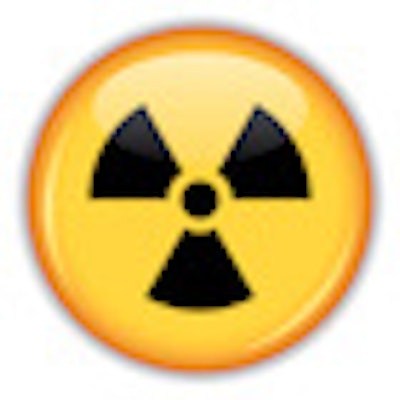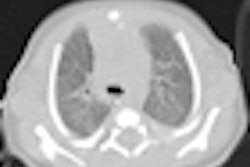
Radiation exposure from two or three head CT scans in childhood -- giving a cumulative dose of around 60 mGy -- can triple the risk of developing brain cancer, while five to 10 such scans (cumulative dose around 50 mGy) may triple the risk of developing leukemia, according to a major study published online on 7 June by Lancet.
The absolute risk of these cancers occurring after CT is small, but radiation doses from CT scans should be kept as low as possible and alternative procedures that do not use ionizing radiation should be considered if appropriate, noted the U.K. and North American authors.
"Further refinements to allow reduction in CT doses should be a priority, not only for the radiology community, but also for manufacturers," said lead author Dr. Mark Pearce, a reader in lifecourse epidemiology from the Institute of Health and Society, Newcastle University, U.K. "Of utmost importance is that where CT is used, it is only used where fully justified from a clinical perspective."
The immediate benefits of CT outweigh the potential long-term risks in many cases, and because of CT's diagnostic accuracy and speed of scanning, notably removing the need for anesthesia and sedation in young patients, it will, and should, remain in widespread practice for the foreseeable future, he stressed.
"It's well known that radiation can cause cancer but there is an ongoing scientific debate about whether relatively low doses of radiation like those received from CT scans do increase cancer risks, and if so the magnitude of those risks," added co-author Dr. Amy Berrington de González, from the National Cancer Institute (NCI), Bethesda, Maryland, U.S. "Ours is the first study to provide direct evidence of a link between exposure to radiation from CT in childhood and cancer risk, and we were also able to quantify that risk."
The study represents the culmination of almost two decades of research in this area, and is jointly funded by the U.K. Department of Health, the NCI, and National Institutes of Health. The authors studied nearly 180,000 patients who underwent a CT scan between 1985 and 2002 from the radiology departments of some 70% of the U.K.'s hospitals.
They extracted the number and types of CT scan from the records, and for each scan they estimated the dose absorbed by the brain and bone marrow in patients. These data were then linked to cancer incidence and mortality reports in the U.K. National Health Service Registry between 1985 and 2008. From this, they calculated excess incidence of leukemia and brain tumors.
The dose of radiation received by the brain and bone marrow varied by age, and body part scanned, as shown in table 1.
A total of 74 from 178,604 patients were diagnosed with leukemia, and 135 of 176,587 were diagnosed with brain cancer. The authors calculated that the relative risk of leukemia increased by 0.036 per extra mGy received, whilst for brain tumors, this increased risk was 0.023. Compared with patients who received a dose of less than 5 mGy, patients who received a cumulative dose of at least 30 mGy (mean 50 mGy) had around three times the risk of leukemia. Patients receiving a cumulative dose of 50-74 mGy (mean 60 mGy) had triple the risk of developing primary brain tumors.
According to the authors, of every 10,000 people between the ages of 0 and 20 receiving 10 mGy from a CT scan, there would be about one expected excess leukemia case, whereas there were would be one excess case of brain cancer for every 30,000 people. Applying the dose estimates for one head CT scan before the age of 10, this would translate into approximately one excess case of leukemia and one excess brain tumor per 10,000 patients in the decade after first exposure. However, increased follow-up and analysis of other cancer types is needed to identify the total excess risk for all cancers associated with CT scans, they pointed out.
In the U.K., the Ionizing Radiation (Medical Exposure) Regulations mean that a CT scan should only be done when clinically justified, and this might explain the relatively low levels of CT use in the U.K. compared with other countries that do not have such regulations, Pearce stated.
(To view information regarding other national cohort studies of children and CT exposure and cancer incidence, see table 2.)
"This study should reduce the debates about whether risks from CT are real, but the specialty has anyway changed strikingly in the past decade, even while the risk debate continued," noted Dr. Andrew Einstein, from the New York Presbyterian Hospital and Columbia University Medical Center in New York, in a linked commentary. "New CT scanners all now have dose-reductions options, and there is far more awareness among practitioners about the need to justify and optimize CT doses -- an awareness that will surely be bolstered by Pearce and colleagues' study."
The study confirms that CT scans almost certainly produce a small cancer risk, but as the use of CT continues to rise, generally with good clinical reasons, everybody must redouble their efforts to justify and optimize every CT scan, he concluded.
For further details about this study, click here.



















